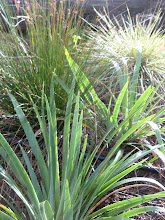 (not my picture.)
(not my picture.)A few years ago in a contemporary art class, I became aware of Wolfgang Laib, a German artist who spends whole days collecting pollen, usually from dandelions. He brings the pollen into museums and puts it in piles on the floor. How unusual.
True, there is something monastic about the look of these piles and his other work that appeals to me. Maybe because I draw with chalky pastels I can appreciate the glow of a simple pile of yellow pigment, but I suspect that there is more magic here.
So I’m thinking…
 (not my SEM image.)
(not my SEM image.)His piles are actually more than pigment. The mechanics of each grain of pollen is incredible, having emerged from millions of years of evolution. I’m reminded that “simple” pollen, like all life, is much more complex and awesome than the Mona Lisas we usually find in the museum.

After graduation I took an internship at an arboretum in Flagstaff, AZ. I did a variety of work there, and sometimes I spent hours in the wild grasses behind the arboretum collecting their seeds in bags for the collection. I’d just pull them off between my finger and thumb, as I walked by.
There is something so down-to-earth (humble, wholesome, patient) and meditative about tasks like these, and I imagine this is much like collecting pollen. Maybe this is some of the magic he is expressing, the kind of magic that’s easy to lose and forget about these days.

(not my photo.)
While bees feed on pollen (and feed pollen to their young), Laib exhibits and sells pollen to make a living. Maybe the acknowledgement that our lives depend on simple things like plants, air, and soil, and that we tap into these basic sources just like the common bee, is part of the magic.
Luckily we can experience these kinds of magic in the garden. No, not because gardens are full pollen (though I guess it could be). Gardens are places in which we can admire and interact with other life, where we can get back down to earth, and where we can directly tap into the systems that keep us alive (maybe by eating huckleberries from the bush).
Is Laib’s pollen collecting minimalist gardening?

4 comments:
Interesting to think of pollen as food. It's basically a ball of DNA wrapped in sugar. What's a bee's source of protein? Do they make it from metabolized DNA? What do their little bee bodies do with all that DNA?
"Bees are adapted for feeding on nectar and pollen, the former primarily as an energy source, and the latter primarily for protein and other nutrients. Most pollen is used as food forlarvae."
wikipedia under "Bees."
" Entomophilous (literally insect-loving) plants produce pollen that is relatively heavy, sticky and protein-rich."
wikipedia under "Pollen."
So pollen is a bee's source of protein, but it's not from the DNA. I'm guessing that they metabolize DNA into nucleotides (and some sugar and minerals) that they use as the building blocks for their own DNA. Or do they have to completely metabolize it and build their own nucleotides?
Ah, an answer:
"Nucleotides are made from amino acids, carbon dioxide and formic acid in pathways that require large amounts of metabolic energy.[78] Consequently, most organisms have efficient systems to salvage preformed nucleotides.[78][79]
wikipedia under "metabolism."
I forget how much information is available on Wikipedia. Hardly need textbooks anymore.
It's an amazing resource. Sometimes I worry about relying on it so much.
Post a Comment